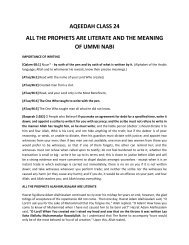81-0158RK-04
Create successful ePaper yourself
Turn your PDF publications into a flip-book with our unique Google optimized e-Paper software.
0.0015–23.5% Oxygen; 0.0005–1.0% Carbon Monoxide; 0.001–0.025% Hydrogen Sulfide; 0–1% Isobutane; Nitrogen Gas balance<br />
releases should be responded to by trained personnel using pre-planned procedures.<br />
Proper protective equipment should be used. In case of a leak, clear the affected area,<br />
protect people, and respond with trained personnel.<br />
6.2 Environmental precautions<br />
●<br />
Avoid release to the environment.<br />
6.3 Methods and material for containment and cleaning up<br />
Containment/Clean-up<br />
Measures<br />
6.4 Reference to other sections<br />
Section 7 - Handling and Storage<br />
7.1 Precautions for safe handling<br />
●<br />
●<br />
Allow the gas mixture to dissipate.<br />
If necessary, monitor the surrounding area (and the original area of the release) for<br />
concentrations of component gases.<br />
Concentrations of component gases must be below any exposure limits listed in<br />
Section 8 and Oxygen levels must be above 19.5% before non-emergency personnel<br />
are allowed to re-enter area.<br />
Refer to Section 8 - Exposure Controls/Personal Protection and Section 13 - Disposal<br />
Considerations.<br />
Handling ● Use good safety and industrial hygiene practices. Use only with adequate ventilation.<br />
Be aware of any signs of dizziness or fatigue, especially if work is done in a poorly<br />
ventilated area; exposures to fatal concentrations of this gas mixture could occur<br />
without any significant warning symptoms, due to olfactory fatigue or oxygen<br />
deficiency. Cylinders should be firmly secured to prevent falling or being knocked-over.<br />
Do not attempt to repair, adjust, or in any other way modify cylinders. If there is a<br />
malfunction or another type of operational problem, contact nearest distributor<br />
immediately.<br />
7.2 Conditions for safe storage, including any incompatibilities<br />
Storage ● Cylinders should be stored in dry, well-ventilated areas away from sources of heat,<br />
ignition and direct sunlight. Do not allow area where cylinders are stored to exceed<br />
52°C (125°F). Cylinders must be protected from the environment, and preferably kept<br />
at room temperature (approximately 21°C (70°F). Cylinders should be firmly secured<br />
to prevent falling or being knocked-over. Protect cylinders against physical damage.<br />
Store locked up.<br />
7.3 Specific end use(s)<br />
●<br />
Refer to Section 1.2 - Relevant identified uses.<br />
Section 8 - Exposure Controls/Personal Protection<br />
8.1 Control parameters<br />
Isobutane<br />
(75285)<br />
Exposure Limits/Guidelines<br />
Result ACGIH Canada Ontario Canada Quebec China Germany DFG<br />
TWAs<br />
1000 ppm TWA<br />
(listed under Aliphatic<br />
hydrocarbon gases:<br />
Alkane C14)<br />
800 ppm TWA (listed<br />
under Aliphatic<br />
hydrocarbon gases)<br />
Not established Not established Not established<br />
Ceilings Not established Not established Not established Not established<br />
MAKs Not established Not established Not established Not established<br />
4000 ppm Peak<br />
(listed under Butane);<br />
9600 mg/m3 Peak<br />
(listed under Butane)<br />
1000 ppm TWA MAK;<br />
2400 mg/m3 TWA<br />
Preparation Date: 08/May/2012<br />
Revision Date: 08/May/2012<br />
Page 6 of 20<br />
Format: EU CLP/REACH Language: English (US)<br />
OSHA, WHMIS, UN GHS, EU DSD/DPD, EU CLP






